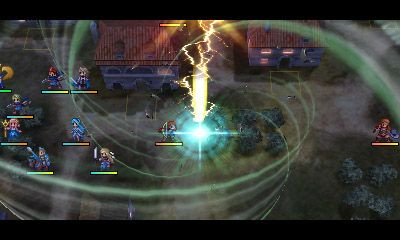Any veteran player of the Fire Emblem games knows that your units will have to make it through various maps against a myriad of enemies.
To combat these enemies, you’ll have different types of heroes and weapons that will help you on your way to getting out of each map alive.
Battling in Fire Emblem Fates remains relativity the same from Awakening but with some minor tweaks to the battlefield. We’ve compiled this battle guide to help any first-time players of Fire Emblem get through the war between Hoshido and Nohr in one piece.
BASICS
Using your cursor, once you highlight a unit blue squares will appear on the map. This shows where that unit can move. If you highlight an enemy unit, red squares will appear and show where they can move. You can plan where to place your units to avoid being in the crosshairs of an enemy.
To attack enemies, you need to move your unit adjacent from the enemy and choose attack. A screen will appear in the lower screen that shows how much damage you’ll deal, the hit percentage and whether there will be a follow up attack.
Use this to decide on whether to attack or not.
MOVEMENT SPEED
Think of each map in Fire Emblem Fates as a chess board. You’ll move your units around the board until you reach your mission objective, whether its defeat every enemy, seize a stronghold or escape a map.
Every unit has a certain amount of spaces it can move on the map. This number can be found right below both the LV and EXP. Each unit’s class affects this stat and can’t be changed in any way (unless the unit has the Movement +1 ability).

It’s worthy to note that any unit with a steed (such as a horse, pegasus or wyvern) will have a higher movement number and those with heavy armor like Knights and Generals will have lower movement numbers. Keep that in mind when choosing your units but there is a technique to help move slower units faster.
PAIR UP
The pair up technique can be done by any unit. All you have to do is move one unit next to another and choose “Pair Up.” This allows for the unit to protect the other and become the lead unit.
The lead unit will gain a stat boost from the covered unit while the covered unit will be hidden from attackers.
During battles, the lead unit will be the one attacking while the covered unit will protect the lead from any follow-up attacks, negating any damage. Also, you will accumulate points that will eventually trigger Dual Guard, which will negate all attacks.
The paired up unit will have the same movement speed as the lead, so if you have a steed unit to act as the lead you can move slower units in no time. This is also a great way to protect your units on the verge of death from being defeated.
If the lead unit is defeated, the covered unit will be placed in that space.

SUPPORT UNITS
If you move a unit adjacent to another in your party and attack, you’ll support each other in battle. The non-attacking unit will boost the attacking unit’s stats and will even sneak in an attack (this follow-up is weaker than a normal attack).
The support relationship between the two units affects how much of a stat boost you’ll receive and even how much damage is dealt on the follow-up.
TERRAIN
Every map will have different terrain, whether it’s tall grass, mountains etc.. you’ll have to maneuver your units across these obstacles.
Flying steeds like Pegasus and Wyverns can fly over almost anything. Large body of water? Just have one of them fly over it. Any unit on horseback will also be able to travel over different types of terrain like mountains and cliffs easier than anyone on foot.
But terrain in Fates doesn’t just affect movement, it can affect battles. If your unit is in a different type of terrain like tall grass, it will give your unit a boost in stats specifically your SKILL stat on offense and your chance to avoid attacks on defense.
This is also true for the enemy so be sure to get the terrain advantage first.

DRAGON VEIN
The newest addition to the Fire Emblem franchise is the Dragon Vein ability. The royal family of both Nohr and Hoshido have dragon blood in them and can access the Dragon Veins that are littered throughout the maps of Fates.
The Dragon Veins in each map act differently and can really help your army traverse each area. Some examples of the Dragon Vein functions are moving walls in strongholds, cratering mountains and freezing large bodies of water so your army can walk across.
Some Dragon Veins are permanent and others are temporary, be sure to check out their function by hovering over each Dragon Vein with the cursor and plan accordingly.
STATS
The stats of every unit determines what role they play in battle. Some are frontline tanks with high attack and defense while others can be well-balanced or healers.
Here are each stat and what they do:
STR = The strength affects damage the unit deals with physical attacks.
SPD = The speed stat affects a unit’s avoidance rate. It also allows a unit to strike twice if the speed stat has five more than the opponent.
MAG = The magic stat affects the damage from tomes.
LCK = The luck stat has various effects that normally affects a unit’s ability proc rate. But it lowers the risk of enemy critical hits.
SKILL = This affects the hit rate and the frequency of critical hits.
DEF = The defense stat reduces damage from physical attacks.
RES = The resistance stat reduces the damage from magical attacks.
Each class is strong and weak in certain stats and with every level up, those stats will increase faster than others.
There are various items in the game that can raise certain stats permanently or for just one battle.
WEAPON TYPES
In the past, the weapon advantages and disadvantages were based on the type of weapon. In Awakening this was simplified by designating red, blue and green for each weapon type. This allows for an easier advantage chart in Fire Emblem.
Swords and tomes are designated with red, axes and bows are green, and staffs and daggers/shurikens are blue. Red beats green, green beats blue and blue beats red. This is called the Weapon Triangle.
Before you go into battle, you’ll see whether a weapon will be strong or weak against the enemy’s weapon in the lower screen. You’ll see either a red downward arrow designating a disadvantage or a green upward arrow designating an advantage.
Certain weapons are also really strong against certain enemies. These are usually in the text of each weapon but, for example, bows are inherently strong against pegasus and wyvern riders. A horse icon will be shown next to these weapons. Make sure to check the archer’s range before moving your flying units so you don’t accidentally put them in a kill zone.
WEAPON GRADES
Older Fire Emblem games also had different metal types affect weapon advantages and disadvantages. There were bronze, iron and steel weapons but in Fates the different metal indicates the weapon’s grade.
The lowest grade of a weapon is E with A being the highest. Every unit begins with E and as you use the weapon type, your unit’s proficiency with that weapon increases.
The higher the grade of your weapon, the stronger it is and will likely come with different abilities.
And that’s the basics to battling in Fire Emblem: Fates. Is there anything we missed? Sound off in the comments section below.


















